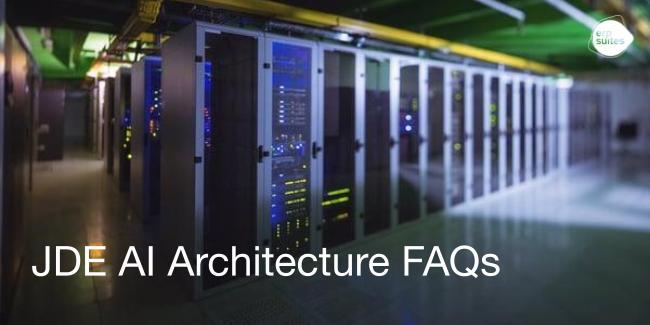Five ways to call JD Edwards orchestrations
March 31st, 2020
3 min read

You created the perfect orchestration that nails your business requirements. Now how will you unleash this greatness into the world? In other words, what are your options for calling orchestrations? By now, you likely know that any software capable of making REST calls and handling JSON is a potential interface for orchestrations. Can it be that simple? Yes! Here are five interfaces you can use to interact with Orchestrator:
Mobile devices
Mobile devices provide unprecedented flexibility. Once working late meant solitary confinement in the home office. Now you can join the family on the couch and never miss a ballgame. And with orchestrations, it's even easier to take it with you.
A good mobile developer with a reliable platform will place most, if not all, of your business logic in orchestrations. Your in-house developers can then leverage Android/iOS skills to create front-end displays that capture data and call the orchestrations. With the business logic stored in the orchestration, your end-user can pull out their phone, review data, and immediately take action.
Expecting a cab? Approve the backlog of requisitions while you wait.
Walking into a sales meeting and forgot what the customer ordered? Quickly search their available orders.
Found a new lead? Snap a photo of their business card and automatically update JDE.
Classic E1 Pages
If you prefer the comfort and security of your JDE ecosystem, there's another solution. Classic E1 Pages enable you to develop powerful web pages using the latest JavaScript libraries right from JDE. Better yet, there's a JavaScript tool to help. Oracle's e1pagehelper.js gives Classic E1 Pages access to AIS and orchestrations while maintaining your user's current session. That means (insert drum roll) you can perform orchestrations right from the JDE home page!
Want to limit contractor access to a handful of JDE apps or tasks? Use Classic E1 Pages to create a standalone web page, add to existing Composed Pages, or leverage Simplified (kiosk) Mode.
Microsoft Excel
In 2016, Microsoft boosted 1.2 billion corporate Office customers. IT organizations tried to pivot, but JDE users held firm. Despite tedious "import this/export that" tasks, they simply love to number crunch in Excel. But there is a way to have your XLS cake and eat it too. Remember, anything supporting REST can do orchestrations. And Visual Basic for Applications (VBA) offers REST capabilities. Interfacing with orchestrations, you can perform tasks that add, update, and pull JDE data from Excel in real-time. It's a little tough to implement but is, by far, the most common orchestration request we see at ERP Suites.
It's hardly fair to build excitement for calling orchestrations with Excel macros, then let you down with complexity. There is hope. Beginning with Studio 7.2+ (Tools 9.2.3.3+), orchestrations can import CSV files. So you don't need a VBA developer. Set up an FTP (File Transfer Protocol) connection where Orchestrator can grab the CSV instead. It's easy. Save your Excel file as a CSV. Then at the push of a button—or right on schedule—Orchestrator will plug it into JDE.
Cloud services
Outbound orchestrations leverage third-party cloud services for a wide variety of situations. We've shared a few in pasts posts, such as address verification and currency rate lookups. You might also create an outbound call to track shipments or provide weather updates by location. ERP Suites customers have capitalized on cloud services to automate order entry from emails or fax where EDI is not available or cost-effective. Still, many cloud vendors offer high-end services that harness artificial intelligence, robotic process automation, or emotion tracking to push your solution even further. If you can think of an application service, there is likely a REST-based web service available to work with orchestration.
Third-party (and not so third-party) applications
Many third-party applications now have a REST interface. That opens a whole new toolbox. With some custom development using programming languages such as Python, .NET, Visual Basic, or cURL scripts, you can create a data exchange via orchestration. Not so third-party, JD Edwards applications can leverage orchestrations too. You might use a Form Extension to call a cloud service directly form JDE—with no coding. Or, code an orchestration into JDE's event rules using the B98ORCH function.
No matter how simple or how elaborate the interface, at the end of the day, it's just calling orchestrations. Your business logic and flows remain safely tucked inside JDE Orchestrator. So don't be afraid to explore these popular user interfaces and unleash the power of orchestration.
Need help getting started? Click to learn about Orchestrator Services. ERP Suites is a JD Edwards Gold Partner and winner of the 2019 Oracle Distinguished Partner Award for Successful Adoption of Orchestrator.
Frank Jordan, Tom Liptak, Eric Poff
Frank, Tom and Eric are frequent Oracle JD Edwards conference presenters dedicated to bringing digital transformation within reach. Their collective solutions have earned ERP Suites multiple JDE Distinguished Partner Awards specializing in orchestration and integrating digital technology for increased productivity.
Topics:



.png?width=650&height=325&name=Blog%20Images%202_1%20(4).png)
.png?width=650&height=325&name=Blog%20Images%202_1%20(5).png)
.png?width=650&height=325&name=Blog%20Images%202_1%20(3).png)
.png?width=650&height=325&name=Blog%20Images%202_1%20(2).png)
.png?width=650&height=325&name=Blog%20Images%202_1%20(1).png)
.png?width=960&height=540&name=Blog%20Images%20(96).png)

.png?width=960&height=540&name=Blog%20Images%20(90).png)
.png?width=960&height=540&name=Blog%20Images%20(88).png)
.png?width=960&height=540&name=Blog%20Images%20(87).png)
.png?width=960&height=540&name=Blog%20Images%20(86).png)
.png?width=960&height=540&name=Blog%20Images%20(85).png)
.png?width=960&height=540&name=Blog%20Images%20(83).png)
.png?width=960&height=540&name=Blog%20Images%20(82).png)
.png?width=960&height=540&name=Blog%20Images%20(80).png)